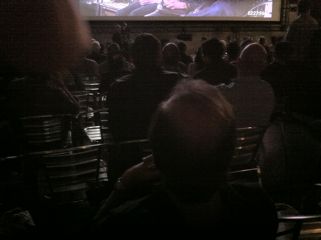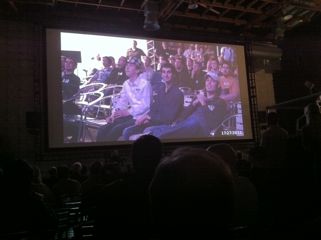Last week I was a the official Storm launch at RED Studios. While Storm – the RED Digital Cinema Camera Production Hub – is undoubtedly going to be the “go to” app for  anyone working with RED footage, it wasn’t what set my mind thinking about lighting.
Before I get to that though, I was very impressed with Storm in every way (without having actually used it myself). Well thought out and priced appropriately, if you have to work with RED, you will end up buying Storm.
What set me thinking was the demonstration of RED Epic where the incredible low light performance and high dynamic range combined to kind of answer a question I’ve have had in my mind for a while.
It’s long been my understanding that the progression of the importance of lighting has gone from:
- We need an enormous amount of light just to get an image on film (thank you California sunshine and studio arc lights) to
- We need light to reduce the contrast range so the image we have will be usable.
Of course, there’s a third use that I doubt will go way, and that’s the use of lighting for creative effect and mood building.
Having seen the results from RED Epic though – up on the most amazing 4K projection system btw – I wonder about the two traditional reasons for using lighting gear.
Ted Schilowitz turned the Epic on the audience in the sparsely lit Studio 4. The audience were dimly lit, mostly from the spill of the ‘stage’ lighting, itself not real bright. This is a pretty accurate photo of what it looked like.
Â

When first turned on Epic produced a full quality image in less than about 20 seconds, which is a huge improvement on the RED One camera. At its default of 800 ASA, the audience were dark, but it was probably a usable image. Very clean so likely to be able to be pushed in post to usable.
But that wasn’t the point. As I’m sure you know, RED records all that the sensor sees so ASA is a fairly flexible concept. Ted ramped Epic up to 5,000 ASA and the screen image became almost too bright to watch – with no increase in available light.
Â

Now a photo of a screen isn’t ever going to convey anything but the broadest outline of the point, but at 5000 ASA the image was over bright – it would need to be dialed back. It gained a little contrast in my opinion, but remained amazingly clean and free of image noise at that ASA.
We also got to see a reel of Epic shots, including shots lit only by a match (and with one small spot of mood light in the background); and all sorts of “impossible” lighting conditions all acceptably shot without lighting. So we don’t need light “just to get a picture”! And RED certainly hasn’t been the only camera to produce great images in next to no light, but Epic does it very cleanly.
But to me the killer, and what really set me down the path of asking this question, was a shot from a ranch in the Las Vegas desert (presumably the RED Ranch), shot from inside a barn, wide, and through the open barn door, a desert landscape with a building in the background. The building had a highly reflective iron roof. This shot uses RED’s HDRx mode, which uses a second image to give 3-6 stops of highlight protection.
The native, unprocessed image looked a little dark in the barn, and a little light outside, but no detail had been lost as was obvious when Ted ramped the ASA down to see the detail in the highlights, and up to see the detail in the near blacks. (ASA can be changed in post with RED RAW’s format.) After color timing by someone expert in the craft, the shot looked production quality. Without lighting. In the most challenging conditions.
Some lighting will always be on the cards for creative effect and setting the right visual mood, but truthfully you can light for your eyes and the camera will keep up.
That has some interesting implications for more budget focussed production. The small size of the Epic (and still coming Scarlet) combined with the amazing light sensitivity and dynamic range, makes lighting a creative option rather than production necessity. This would simplify location shooting by reducing the size and number of grip trucks required, and reduce the need to bring generators to location shoots.
Now, I guess you’ll all tell me why this isn’t the case. Go right ahead but do it from factual argument not your prejudice about RED (because it won’t only be RED doing this years from now), nor because “that’s not the way it’s done”, because I’m interested in it because it’s not the way it’s done now!
[UPDATE] FX Guide have a story on an “impossible” shot – from full dark tunnel to full blue sky with one exposure for the shot (as the camera was remotely mounted facing the car).
[UPDATE 2] John Brawley set up comparison tests for available light shooting with six different cameras: 36 and Super 16 film, Red MX, Canon EOS, Arri Alexa, Sony F3.
{Update 3] On Reduser.info there is a post Lighting bill plumets using EPIC.
13 replies on “Why do we need lighting anymore? [Updated]”
You are exactly correct. Lighting now lives almost exclusively in the realm of “want” vs “need”. I’m sitting here cutting a feature shot on RED with the Mysterium X sensor. And it boggles my mind the exposures we’re getting knowing the lighting available on set. And this is just a one light! There’s TONES of latitude left in the image.
We’re talking about shooting a feature in the fall that takes place primarily in one location. The discussion has seriously focused around lighting practically and just flying in bounce or rim lights when needed- which will be a real time saver on our tight budget.
I’m not so young as to not remember fighting tooth and nail for exposure on film stock, so I REALLY appreciate what’s going on right now.
Your photos show that your camera still requires lighting.
Oh yes, MY camera definitely requires lighting – that’s just an iPhone 4. But, you know, the “best” camera is the one you have available 🙂
Well Philip, you’re kind of right but the important thing for me, for many years is not whether we NEED light to get an exposure but to put light where we want it for the image we want to acquire. Especially in the world of interviews and b-roll. I may not need to light the b-roll (much) anymore but I will always light the interviews because they look like ass, and I look like an amateur if I don’t. However, now I can light them with much less power, and often am merely using LED lights on batteries. Makes the whole setup faster and much safer by eliminating (some of) the cables.
Lighting is still a tool to help sculpt your scene. Using only available light only cheats yourself – but having the option of only using available light and still getting a good picture opens up a whole new set of opportunities.
In still photography low noise on high ISO images has opened up the possibilities for what you can do in “run and gun” events (eg. Weddings) but you still want to control your lighting when you can to tell your story. (The lack of light can be the story)
You’re confusing lighting with illumination.
Illumination gives an exposure sufficient for an image to be recorded.
Lighting creates a mood by “painting” the scene. This is the job of the cinematographer / director of photography and why some get paid more than others and receive Oscars in recognition of their work.
I guess the question is whether emerging camera illumination latitude (and resolution) and post-production technologies will truly allow for a post-Cinematography that “equals” what production Cinematographers currently do (assuming equal vision and talent of course).
Judging from the changes of even the last few years it is only a matter of time even if Epic/Storm does not yet do this job.
That’s what set me off James – seeing what Epic is now capable of. Natural light that looks cinematic, with the option to light when “nature” doesn’t co-operate, or when you want a totally unnatural look.
There are surely lots of people who will protest or decry any movie without “lighting” as amateurish, but someone with a good eye for practical or natural light could conceivably film a movie with NO artificial light whatsoever. You could call it an aesthetic choice, but I think if someone was adept enough to make the right decisions, you might never know that a DP wasn’t involved.
It seems to me that documentary filmmakers, and especially nature docs, have been making stunning images without lights for quite some time.
Nice post. I add: We’ll forever want lighting to control our shadows. Shadows (or lack thereof) create mood.
Let’s not confuse natural lighting with available light. I have made many shots with available light that look like I lit them, and have worked very hard to make my lighting look natural and “unlit” when appropriate.
The bottom line here is that the sensitivity of the new sensors will allow cinematographers to concentrate on the aesthetics of lighting and not necessarily the illumination requirements to capture an image.
this is nothing new. i have been lighting locations with generally small lighting packages for years. if the natural light makes for dark eye sockets / simply unattractive looks, then you need lighting. Those sexy shots of cars require lighting, those looks don’t happen by accident.
what is changing is that you don’t need to burn a 100kw or more to get something. you can cut that to 1/4 or less using lower power fixtures. 575’s and 1200’s will now start lighting up entire streets at night, rather then taking a 12K or 18K… unless thats the look you want. in reality, even a 6K would do. no wonder there are a lot of large lights really cheap on ebay these days ! anything over 2400w becomes genie or tie in time so getting rid of those is great. I did a shoot a few months ago and we powered everything up on a 6kw portable that made life really easy. we also stole a 20A wall line in one location.
I’m all for working with reduced lighting packages, it saves everywhere from rental costs, gennie costs, reduced crew requirements, more speed when working, and just saving your talent’s eyes 🙂
I’ve cut my lighting down quite a bit just shooting with dslr’s over some more convetional cameras, so this would be even better. maybe I might have a real reason to get a RED camera now !
Steve you nailed it. We still need to light, but the amount of light – and the consequences for transport, power and heat removal – has dramatically changed. And changes again when a match *could* do the job!
But those dark eye sockets.. gotta fix those.